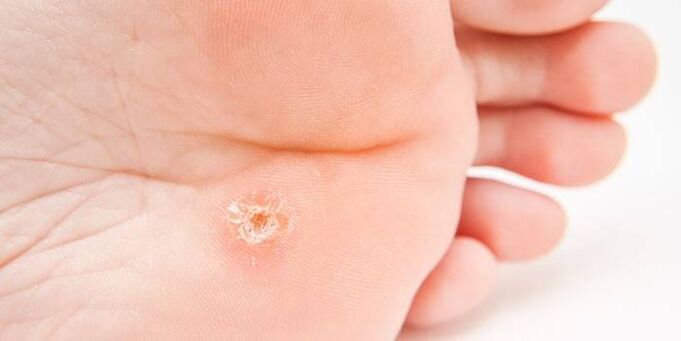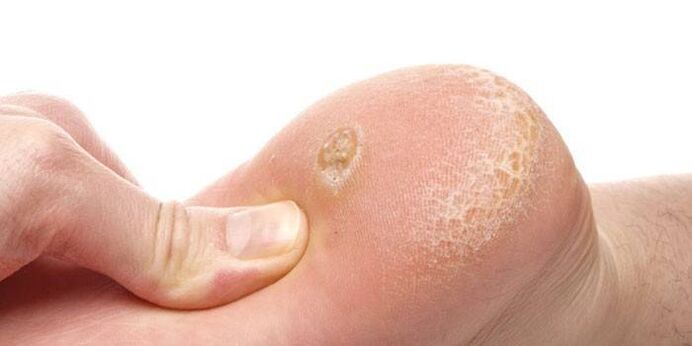Since ancient times, ugly formations in the body have troubled mankind. A wart on the foot is a skin disease caused by a virus. People with skin defects avoided it, fearing infection, and, having noticed a neoplasm in the foot or other part of the body, tried to remove it as soon as possible. What people do not apply to their plantar warts if they disappear forever. So far, dermatologists are looking for the most effective and painless method of treating the disease.
What is a wart
Human papillomavirus provokes a benign or oncological mutation of DNA in skin cells. The body is covered with papillomas, warts, papules. More than a hundred types of HPV have been studied. A wart is a growth of skin that signals the presence of the first or third type of papilloma virus in the body. Neoplasms are potentially non-carcinogenic, but extremely infectious due to the persistence of the pathogen in the external environment.
What does a wart on the foot look like?
The foot neoplasm has a round shape with clear edges a few millimeters or centimeters in size. In the center, black spots of blocked capillaries are visible. On the feet, they look like old dry calluses that have grown on the skin. Pain from the growth of the foot is not manifested under direct pressure, but with compression. The lack of papillary lines in the foot is characteristic.

Causes of plantar warts
HPV infections are more common with unprotected intercourse. The virus penetrates through microcracks in the mucosa of the genitals. Someone's HPV is "in transit", while others are less fortunate - the virus stays in the body without being notified for a long time. Dermatologists do not rule out that the appearance of papillomas on the surface of the feet may be triggered by immunological disorders and infectious diseases.
Walking barefoot in public places: baths, swimming pools, body care salons, shared bathrooms, on the beach, trying on barefoot shoes are the most common causes of plantar warts. The virus is applicable outside its host and "stays waiting for the victim" on towels, plates, washing cloths, furniture, slippers for guests, etc. The infection is withdrawn from dense, tense areas of the skin of the plantar surfaces and palms, where the papilloma virus enters through minor injuries.
Warts on children's feet
Children are anxious, often hurt. Parents may not be aware of the presence of HPV in the child's body, obtained through cuts and scratches. With a weakening of immunity, the virus becomes active, papilloma appears on the legs. Painful methods of treating foot warts in children are often contraindicated, poorly tolerated. Often, the baby's body copes with this foot skin disease on its own.
Types of warts on the feet
Warts are a collection of skin lesions caused by papillomas. Depending on the external manifestation, the impact on human health, the following types of warts are classified:
- vulgar (common) - round keratinized blisters;
- flat - a rash in the form of spots that rise on the skin;
- filiform (acrocords) - elongated with "torn" edges, formed in the folds of the body;
- genital warts - reminiscent of the comb of a rooster;
- senile (keratomas) - occurring in the elderly, are not related to HPV.
Wart formations are localized throughout the body, in the internal organs, in the oral cavity. Warts on the feet, called plantar warts, are a common type. One of the types includes good shape, which are a depressed depression in the skin, characterized by rapid growth. The appearance of subungual growths slightly raises the nail plate.

Treatment of plantar warts
It is dangerous to neglect the treatment of plantar warts. Leg neoplasms are constantly injured. They are removed to stop the emergence of new growths and the entry of infections. There is no complete cure for HPV. Treatment is reduced to turning the disease into a "sleep mode". Disposable treatment, surgical, immunomodulatory removal of plantar warts, using alternative medicine.
The disadvantage of treating plantar growths lies in their location: the large corneum layer of the epidermis makes it difficult to send active substances to the depth of foot formation. In preparation for therapy, the top layer of the collection is soaked and cleaned. Traditionally, treatment of foot warts begins with the use of salicylic acid. Warts on the feet are done every day, for three months, steamed in the bath, disinfected, then the softened top layer is cleaned with a pumice stone, salicylic acid is applied and a patch is applied.
Pharmacy chains advise how to get rid of a wart on the foot with the help of medicines containing celandine, phenol, trichloroacetic acid. Medications cause tissue necrosis, relieving the patient from deficiency, but leaving traces of healing of a deep wart wound. Each disease is individual to varying degrees, therefore, before choosing a method of how to remove a wart on the sole of the foot, you should seek the opinion of your doctor.
Ointment
According to the method of action, there are necrotizing, antiviral, herbal ointments. In the first case, the acid or alkali in the oil base promote painful growth and leave a scar. At home, for the treatment of feet, you can use liquid solutions: with acetic acid, nitric, oxalic, lactic in composition. To avoid burns, the surface of the neoplasm is rigorously processed.
Antiviral ointment for foot warts is applied to the growth itself and the area around it to reduce the growth of infection. They are used with special ointments. Herbal ingredients only affect skin formation. Known for their effectiveness in treating foot balm with an applicator, kolhamin ointment.
Modern methods of removal
The advent of modern wart removal methods has replaced the traumatic scalpel. Similar to the surgeon's knife, the electrocoagulator burns the neoplasm in the leg with electricity. After the laser or radio wave removal procedure, a depression remains in the leg. Healing takes several weeks. Exposure to liquid nitrogen is considered a very painful treatment and requires several treatments. In 2014, British dermatologists published a paper on the latest antigen injection therapy. It will help patients who are resistant to existing treatments.

Folk remedies
Procedures with folk remedies for warts on the feet are performed at bedtime, with feet steamed in advance and for a long time. During treatment, protect your hands with latex gloves from further spread of infection, disinfect all equipment and things used to prevent infection of loved ones. List of popular ways considered effective to get rid of feet from a wart:
- Garlic is known for its antibiotic properties. In a neoplasm in the sole, the hardened upper layer is cut, a thin clove of garlic is applied.
- You can make "beard dough". It is mixed with finely chopped garlic, vinegar, wheat flour, spread on the surface of the neoplasm and sealed with plaster. After a few days, the dough is removed along with the agglomeration.
- Apply an onion dipped in vinegar on the legs, or you can rub the growth with vinegar, then paste a fresh onion.
- You can fill the formation with the juice of medicinal plants: celandine, kalanchoe, calendula, dairy, dandelion, golden mustache or attach a slice of apple, mountain ash, figs, potatoes, horseradish, cabbage. The procedure is performed daily, lasting from a few weeks to a month, until the accumulation disappears.
- You can apply wood ash diluted in water to a creamy state.
- The growth is sprinkled with powdered chalk and wrapped in a bandage. The compress cannot be wetted.
- Birch and willow bark containing salicylic have proven themselves well in treatment. The bark is applied to the feet, pre-soaking it with boiling water.
- Hot foot baths with sea salt, soda, laundry soap, tea oil or spruce juice help treat foot diseases. Treatments can be mixed or alternated.
- Wormwood soup applications are used. 3 tablespoons of dry wormwood grass are boiled in a glass of boiling water, insisting for at least 2 hours.














































































